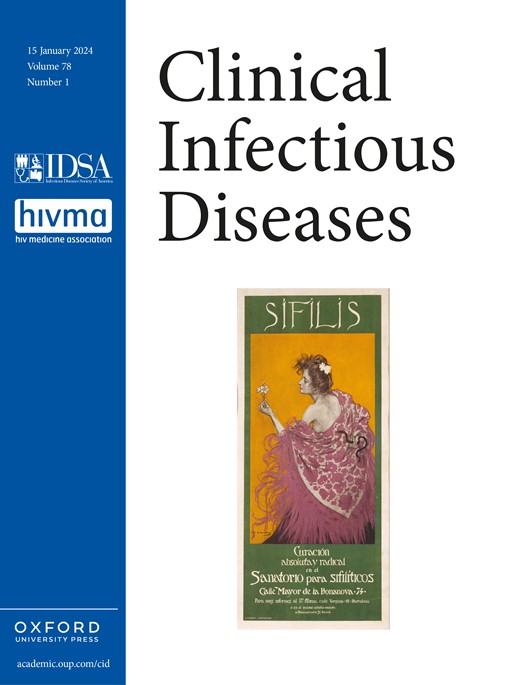Bivalent RSVpreF Vaccine in Adults 18 to <60 Years Old With High-Risk Conditions
IF 8.2
1区 医学
Q1 IMMUNOLOGY
引用次数: 0
Abstract
Background Older individuals and adults with certain chronic or immunocompromising health conditions are at increased risk of severe RSV disease. Methods In this phase 3 randomized trial of RSVpreF safety and immunogenicity in 18−59-year-olds at high-risk of severe RSV disease, participants were randomized 2:1 to 1 RSVpreF (120 µg) or placebo dose. Primary safety endpoints included reactogenicity events and adverse events (AEs) through 7 days and 1 month after vaccination, respectively, and serious AEs (SAEs) and newly diagnosed chronic medical conditions (NDCMCs) throughout the study. In primary analyses, immunogenicity elicited 1 month after RSVpreF was bridged to a randomly selected subset of ≥60-year-olds receiving RSVpreF from the immunogenicity subset in the pivotal phase 3 RENOIR trial, which demonstrated RSVpreF efficacy. Noninferiority was declared if 95% CI lower bounds were >0.667 (neutralizing titer adjusted geometric mean ratios) and >−10% (seroresponse rate differences) for RSV-A and RSV-B. Results Overall, 678 participants received RSVpreF (n=453) or placebo (n=225). Most reactogenicity events were mild/moderate; severe events occurred in ≤2.0% of participants overall. AE frequencies were similar in RSVpreF (7.1%) and placebo recipients (7.6%). No vaccine-related SAEs or NDCMCs were reported. One month after RSVpreF administration, noninferiority criteria were met in 18−59-year-olds versus ≥60-year-olds for RSV-A and RSV-B neutralizing titers and seroresponse rates. Conclusion RSVpreF was well tolerated with no safety concerns and demonstrated immunobridging to efficacy in 18−59-year-olds at high-risk of severe RSV disease versus ≥60-year-olds in whom efficacy was previously demonstrated, supporting use of RSVpreF to prevent RSV-associated disease in this population. NCT05842967.二价 RSVpreF 疫苗适用于 18 岁至小于 60 岁的高危成人
背景老年人和患有某些慢性疾病或免疫力低下的成年人罹患严重 RSV 疾病的风险更高。方法 在这项针对 18-59 岁重症 RSV 高危人群的 RSVpreF 安全性和免疫原性的 3 期随机试验中,参与者按 2:1 的比例随机接受 1 剂 RSVpreF(120 µg)或安慰剂。主要安全性终点包括接种后 7 天和 1 个月内的致反应事件和不良事件 (AE),以及整个研究期间的严重不良事件 (SAE) 和新诊断慢性病 (NDCMC)。在主要分析中,RSVpreF接种1个月后的免疫原性与从关键性3期RENOIR试验免疫原性子集中随机挑选的≥60岁的RSVpreF接种者的免疫原性子集进行了桥接,RENOIR试验证明了RSVpreF的疗效。如果RSV-A和RSV-B的95% CI下限分别为>0.667(中和滴度调整后几何平均比)和>-10%(血清反应率差异),则宣布为非劣效性。结果 共有 678 人接受了 RSVpreF(453 人)或安慰剂(225 人)治疗。大多数反应性事件为轻度/中度;严重事件发生率低于2.0%。RSVpreF(7.1%)和安慰剂受试者(7.6%)的AE频率相似。未报告与疫苗相关的 SAE 或 NDCMC。接种 RSVpreF 一个月后,在 RSV-A 和 RSV-B 中和滴度及血清反应率方面,18-59 岁人群与≥60 岁人群相比达到了非劣效性标准。结论 RSVpreF 的耐受性良好,无安全性问题,在 18-59 岁的严重 RSV 疾病高危人群与先前已被证明有效的≥60 岁人群中,RSVpreF 显示出免疫桥接疗效,支持在该人群中使用 RSVpreF 预防 RSV 相关疾病。NCT05842967。
本文章由计算机程序翻译,如有差异,请以英文原文为准。
求助全文
约1分钟内获得全文
求助全文
来源期刊

Clinical Infectious Diseases
医学-传染病学
CiteScore
25.00
自引率
2.50%
发文量
900
审稿时长
3 months
期刊介绍:
Clinical Infectious Diseases (CID) is dedicated to publishing original research, reviews, guidelines, and perspectives with the potential to reshape clinical practice, providing clinicians with valuable insights for patient care. CID comprehensively addresses the clinical presentation, diagnosis, treatment, and prevention of a wide spectrum of infectious diseases. The journal places a high priority on the assessment of current and innovative treatments, microbiology, immunology, and policies, ensuring relevance to patient care in its commitment to advancing the field of infectious diseases.
 求助内容:
求助内容: 应助结果提醒方式:
应助结果提醒方式:


